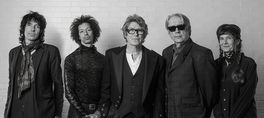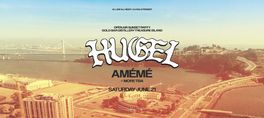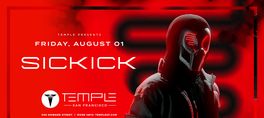In Nowhere Here, Mark Gleason explores the liminal space between the tangible world and the surreal, where literal and symbolic collide. Here are dreamscapes populated by solitary figures, each suspended in a state of anticipation or motion that feels both immediate and eternal. These figures inhabit desolate, barren terrains that extend into the distance like fading memories or half-remembered dreams. In this vast emptiness, they find themselves in dialogue not only with their surroundings but also with the inexplicable and absurd forces that permeate existence.
Gleason's paintings invite the viewer into a quiet confrontation with both the self and the world around us, asking us to contemplate our place within the absurdity of being. Often stripped of overt context, these figures become vessels for meaning, their bodies contorted into positions that suggest both struggle and grace. Stones, chairs, animals, and crowns appear as recurring symbols, elemental in their simplicity yet loaded with connotations of power, burden, and the ephemeral.
Many of Gleason's works capture a delicate tension between balance and collapse, as if the weight of the world is held on the cusp of the viewer's breath. Figures, their bodies straining under unseen forces, evoke a sense of the Sisyphean, where labor and perseverance become metaphors for human existence. Yet, amid the existential weight, there is an underlying sense of optimism--the figures persist, the stones are still borne, the match is still lit. This delicate line between struggle and hope is the animus of Gleason's work.
The hypnagogic atmosphere saturating these paintings encourages the viewer to step beyond the literal and into the symbolic. In Kingdom of What, for example, a man, crowned in paper, cradles a fragile insect as if in communion with something beyond himself--a symbol of the transient nature of life and the solemn responsibility of holding something delicate. Meanwhile, the empty landscapes, painted with almost hyper-real detail, become more than just settings; they are psychological spaces, vast and unknowable, reflecting the inner states of both the figures and the viewer.
Gleason's exploration of place, both literal and metaphoric, speaks to the liminality of human existence--the spaces we occupy between what is known and what is felt, between the real and the surreal. The absence of clearly defined locations becomes a metaphor for those liminal states we often find ourselves in--neither here nor there, but somewhere in between. Figures, at times fully present and at others merely implied, suggest that we, too, exist in this space, part of a larger narrative that remains elusive and incomplete.
This body of work ultimately invites the viewer into an active role, to imagine their own place within the scene. As we confront the figures' isolation, their seemingly absurd gestures, and their quiet persistence, we are invited to reflect on our own internal landscapes. Through Gleason's dream-like vision, Nowhere Here becomes an exploration of what it means to exist--not simply in the oft-complex and mysterious physical world around them, but also in the ever-shifting terrain of human consciousness.
show less
Gleason's paintings invite the viewer into a quiet confrontation with both the self and the world around us, asking us to contemplate our place within the absurdity of being. Often stripped of overt context, these figures become vessels for meaning, their bodies contorted into positions that suggest both struggle and grace. Stones, chairs, animals, and crowns appear as recurring symbols, elemental in their simplicity yet loaded with connotations of power, burden, and the ephemeral.
Many of Gleason's works capture a delicate tension between balance and collapse, as if the weight of the world is held on the cusp of the viewer's breath. Figures, their bodies straining under unseen forces, evoke a sense of the Sisyphean, where labor and perseverance become metaphors for human existence. Yet, amid the existential weight, there is an underlying sense of optimism--the figures persist, the stones are still borne, the match is still lit. This delicate line between struggle and hope is the animus of Gleason's work.
The hypnagogic atmosphere saturating these paintings encourages the viewer to step beyond the literal and into the symbolic. In Kingdom of What, for example, a man, crowned in paper, cradles a fragile insect as if in communion with something beyond himself--a symbol of the transient nature of life and the solemn responsibility of holding something delicate. Meanwhile, the empty landscapes, painted with almost hyper-real detail, become more than just settings; they are psychological spaces, vast and unknowable, reflecting the inner states of both the figures and the viewer.
Gleason's exploration of place, both literal and metaphoric, speaks to the liminality of human existence--the spaces we occupy between what is known and what is felt, between the real and the surreal. The absence of clearly defined locations becomes a metaphor for those liminal states we often find ourselves in--neither here nor there, but somewhere in between. Figures, at times fully present and at others merely implied, suggest that we, too, exist in this space, part of a larger narrative that remains elusive and incomplete.
This body of work ultimately invites the viewer into an active role, to imagine their own place within the scene. As we confront the figures' isolation, their seemingly absurd gestures, and their quiet persistence, we are invited to reflect on our own internal landscapes. Through Gleason's dream-like vision, Nowhere Here becomes an exploration of what it means to exist--not simply in the oft-complex and mysterious physical world around them, but also in the ever-shifting terrain of human consciousness.
In Nowhere Here, Mark Gleason explores the liminal space between the tangible world and the surreal, where literal and symbolic collide. Here are dreamscapes populated by solitary figures, each suspended in a state of anticipation or motion that feels both immediate and eternal. These figures inhabit desolate, barren terrains that extend into the distance like fading memories or half-remembered dreams. In this vast emptiness, they find themselves in dialogue not only with their surroundings but also with the inexplicable and absurd forces that permeate existence.
Gleason's paintings invite the viewer into a quiet confrontation with both the self and the world around us, asking us to contemplate our place within the absurdity of being. Often stripped of overt context, these figures become vessels for meaning, their bodies contorted into positions that suggest both struggle and grace. Stones, chairs, animals, and crowns appear as recurring symbols, elemental in their simplicity yet loaded with connotations of power, burden, and the ephemeral.
Many of Gleason's works capture a delicate tension between balance and collapse, as if the weight of the world is held on the cusp of the viewer's breath. Figures, their bodies straining under unseen forces, evoke a sense of the Sisyphean, where labor and perseverance become metaphors for human existence. Yet, amid the existential weight, there is an underlying sense of optimism--the figures persist, the stones are still borne, the match is still lit. This delicate line between struggle and hope is the animus of Gleason's work.
The hypnagogic atmosphere saturating these paintings encourages the viewer to step beyond the literal and into the symbolic. In Kingdom of What, for example, a man, crowned in paper, cradles a fragile insect as if in communion with something beyond himself--a symbol of the transient nature of life and the solemn responsibility of holding something delicate. Meanwhile, the empty landscapes, painted with almost hyper-real detail, become more than just settings; they are psychological spaces, vast and unknowable, reflecting the inner states of both the figures and the viewer.
Gleason's exploration of place, both literal and metaphoric, speaks to the liminality of human existence--the spaces we occupy between what is known and what is felt, between the real and the surreal. The absence of clearly defined locations becomes a metaphor for those liminal states we often find ourselves in--neither here nor there, but somewhere in between. Figures, at times fully present and at others merely implied, suggest that we, too, exist in this space, part of a larger narrative that remains elusive and incomplete.
This body of work ultimately invites the viewer into an active role, to imagine their own place within the scene. As we confront the figures' isolation, their seemingly absurd gestures, and their quiet persistence, we are invited to reflect on our own internal landscapes. Through Gleason's dream-like vision, Nowhere Here becomes an exploration of what it means to exist--not simply in the oft-complex and mysterious physical world around them, but also in the ever-shifting terrain of human consciousness.
read more
Gleason's paintings invite the viewer into a quiet confrontation with both the self and the world around us, asking us to contemplate our place within the absurdity of being. Often stripped of overt context, these figures become vessels for meaning, their bodies contorted into positions that suggest both struggle and grace. Stones, chairs, animals, and crowns appear as recurring symbols, elemental in their simplicity yet loaded with connotations of power, burden, and the ephemeral.
Many of Gleason's works capture a delicate tension between balance and collapse, as if the weight of the world is held on the cusp of the viewer's breath. Figures, their bodies straining under unseen forces, evoke a sense of the Sisyphean, where labor and perseverance become metaphors for human existence. Yet, amid the existential weight, there is an underlying sense of optimism--the figures persist, the stones are still borne, the match is still lit. This delicate line between struggle and hope is the animus of Gleason's work.
The hypnagogic atmosphere saturating these paintings encourages the viewer to step beyond the literal and into the symbolic. In Kingdom of What, for example, a man, crowned in paper, cradles a fragile insect as if in communion with something beyond himself--a symbol of the transient nature of life and the solemn responsibility of holding something delicate. Meanwhile, the empty landscapes, painted with almost hyper-real detail, become more than just settings; they are psychological spaces, vast and unknowable, reflecting the inner states of both the figures and the viewer.
Gleason's exploration of place, both literal and metaphoric, speaks to the liminality of human existence--the spaces we occupy between what is known and what is felt, between the real and the surreal. The absence of clearly defined locations becomes a metaphor for those liminal states we often find ourselves in--neither here nor there, but somewhere in between. Figures, at times fully present and at others merely implied, suggest that we, too, exist in this space, part of a larger narrative that remains elusive and incomplete.
This body of work ultimately invites the viewer into an active role, to imagine their own place within the scene. As we confront the figures' isolation, their seemingly absurd gestures, and their quiet persistence, we are invited to reflect on our own internal landscapes. Through Gleason's dream-like vision, Nowhere Here becomes an exploration of what it means to exist--not simply in the oft-complex and mysterious physical world around them, but also in the ever-shifting terrain of human consciousness.
show less
Date/Times:
Ryan Graff Contemporary
10 Upcoming Events
804 Sutter Street, San Francisco, CA 94109
The Best Events
Every Week in Your Inbox
From Our Sponsors
UPCOMING EVENTS
Great suggestion! We'll be in touch.
Event reviewed successfully.









